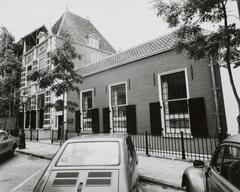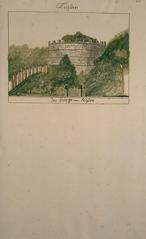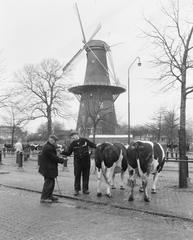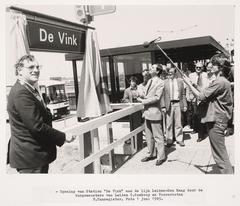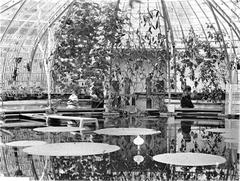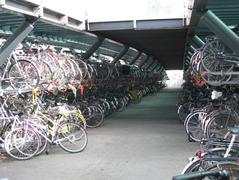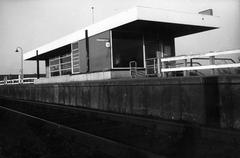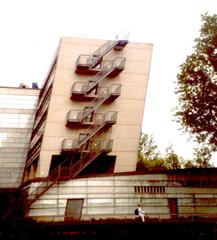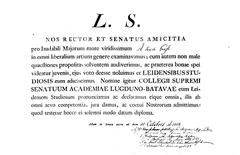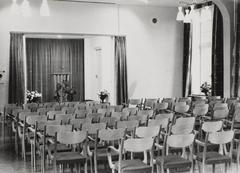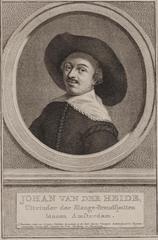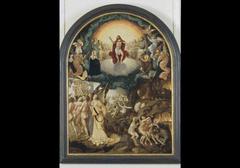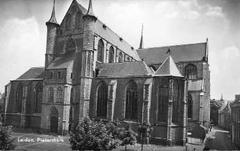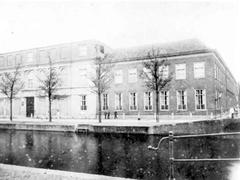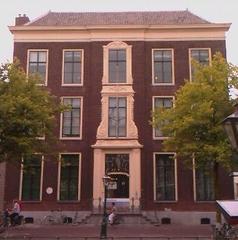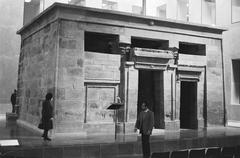Marepoortsbrug Visiting Hours, Tickets, and Leiden Historical Sites Guide
Date: 04/07/2025
Introduction to Marepoortsbrug and Its Significance in Leiden
Nestled in the historic city of Leiden, the Marepoortsbrug stands as a captivating emblem of Dutch heritage and urban development. This stone arch bridge, first constructed in 1611 during Leiden’s early 17th-century expansion, serves as both a vital pedestrian and cyclist crossing over the Korte Mare canal and a tangible link to the city’s Golden Age. Named after the nearby Marepoort—a city gate that once marked Leiden’s northern boundary—the bridge reflects centuries of architectural evolution and urban morphology. Today, visitors can traverse Marepoortsbrug at any time, enjoying picturesque canal views and the layered history of this landmark. Whether you are drawn by its classicist design, its historic role in trekschuit trade routes, or the lively cultural events nearby, Marepoortsbrug offers a multifaceted experience in the heart of Leiden (nl.wikipedia.org/wiki/Marepoortsbrug; novaontheroad.com; Monumenten.nl).
Contents
- Introduction
- Early Urban Expansion and the Origins of Marepoortsbrug
- The Marepoort: From Medieval Tower to Classicist Gate
- The Bridge’s Role in Trade and Transportation
- Architectural Evolution and Restoration
- Visiting the Marepoortsbrug: Practical Information
- Visiting Hours and Accessibility
- How to Get There
- Best Time to Visit
- Nearby Attractions and Facilities
- Visuals and Media
- Frequently Asked Questions (FAQ)
- The Demise of the Marepoort and the Bridge’s Enduring Legacy
- Marepoortsbrug in Leiden’s Urban Morphology
- Conclusion: Experience a Living Monument
- Call to Action
- Key Dates and Facts
Early Urban Expansion and the Origins of Marepoortsbrug
The Marepoortsbrug, a fixed stone arch bridge, connects the Nieuwe Mare and the Korte Mare, spanning the Korte Mare canal (nl.wikipedia.org/wiki/Marepoortsbrug). Its origins date to 1611, during a period of rapid urban expansion in Leiden, when the city council commissioned new neighborhoods and vital infrastructure, including this first version of the bridge.
Named after the nearby Marepoort—a historic city gate itself named for the Mare, a former peat river canalized as part of the trekschuit (horse-drawn barge) route to Haarlem—the bridge occupied a strategic position at Leiden’s northern edge, crucial for both defense and commerce (geschiedenisvanzuidholland.nl).
The Marepoort: From Medieval Tower to Classicist Gate
Replacing the medieval Maretoren water gate (1355) in 1602, the Marepoort evolved from humble beginnings to a classicist masterpiece by architect Willem van der Helm in 1665–66. The gate featured Ionic pilasters, sculptural reliefs, and a lantern, symbolizing both security and civic pride (nl.wikipedia.org/wiki/Marepoort). The Marepoort welcomed travelers arriving via the trekschuit, while the Marepoortsbrug facilitated the movement of people and goods into the city.
The Bridge’s Role in Trade and Transportation
Far more than a crossing, Marepoortsbrug was integral to Leiden’s commercial life. Positioned on the Korte Mare canal, it was the arrival point for trekschuiten connecting Leiden and Haarlem, with up to nine daily journeys lasting about four hours (geschiedenisvanzuidholland.nl). The bridge not only contributed to local trade but also underscored Leiden’s role as a hub in regional transport networks.
Architectural Evolution and Restoration
Constructed originally in 1611, the Marepoortsbrug has undergone several renewals—in 1665, 1785, and 1824—to adapt to the city’s changing needs (nl.wikipedia.org/wiki/Marepoortsbrug). Recognized as a national monument in 1968, the bridge has been carefully restored, most recently in 1974 and 1994, to preserve its stone arches and historical character.
Visiting the Marepoortsbrug: Practical Information
Visiting Hours and Accessibility
Marepoortsbrug is a public bridge open year-round, 24 hours a day, with no entrance fee. Both pedestrians and cyclists can use the bridge freely. Its gentle slopes and absence of steps ensure accessibility for visitors with mobility impairments and parents with strollers.
How to Get There
Located in Leiden’s city center, the bridge is easily reachable by foot or bicycle. Public transit options include buses stopping nearby, and the area features bike racks for cyclists. For drivers, parking garages such as Haagweg provide access with shuttle services (Travelers Universe).
Best Time to Visit
Spring and early autumn are ideal, offering mild weather and fewer crowds. Early mornings and late afternoons provide optimal light for photography and a tranquil canal ambiance. During local festivals, the bridge area becomes especially vibrant.
Nearby Attractions and Facilities
- Marekerk (1649): Historic church close to the bridge
- Leiden City Center: Museums, shops, and cafés
- Canal Tours: Guided boat tours passing under Marepoortsbrug
- De Burcht: Medieval fortress with panoramic city views
- Haarlemmerstraat: Main shopping street
Public restrooms are available in nearby cafés and public buildings.
Visuals and Media
Find high-quality images and virtual tours on Leiden’s official tourism websites. The bridge’s stone arches, classicist surroundings, and canal views make it a favorite subject for photographers and artists.
Frequently Asked Questions (FAQ)
Q: Are there any tickets or fees to visit Marepoortsbrug?
A: No, the bridge is free and open to the public at all times.
Q: Is Marepoortsbrug wheelchair accessible?
A: Yes, the bridge’s gentle slopes accommodate wheelchairs and strollers.
Q: When is the best time to visit for photography?
A: Early morning and late afternoon offer the best light and fewer crowds.
Q: Are there guided tours that include Marepoortsbrug?
A: Yes, several local walking tours feature the bridge as a highlight (Ostrich Trails).
Q: Can I take a canal boat tour passing under Marepoortsbrug?
A: Yes, many canal tours include Marepoortsbrug on their route.
The Demise of the Marepoort and the Bridge’s Enduring Legacy
While the Marepoort city gate was demolished in 1864 due to urban modernization, Marepoortsbrug endures as a cherished landmark. Its name preserves the memory of Leiden’s former fortifications and reflects the city’s ongoing commitment to heritage conservation.
Marepoortsbrug in Leiden’s Urban Morphology
Marepoortsbrug illustrates Leiden’s unique delta city geography, where waterways and bridges dictated urban growth and connectivity (leidenkennisstad.nl). Slow expansion in the 19th century helped preserve structures like Marepoortsbrug, making them integral components of the city’s living history.
Conclusion: Experience a Living Monument
Marepoortsbrug offers a window into Leiden’s past and present. Crossing the bridge or exploring its surroundings, you’ll experience the city’s heritage, culture, and stunning canal vistas. Whether as a photography spot, a part of a walking route, or simply as a peaceful place to pause, the bridge invites you to engage with Leiden’s history.
Call to Action
For a deeper experience, download the Audiala app for audio-guided tours of Leiden’s historical sites, including Marepoortsbrug. Follow our social media channels for updates, and explore our related articles to enrich your Leiden adventure.
Key Dates and Facts
| Year | Event |
|---|---|
| 1611 | First Marepoortsbrug constructed during city expansion (nl.wikipedia.org/wiki/Marepoortsbrug) |
| 1627 | Second Marepoort built at Nieuwe Mare (nl.wikipedia.org/wiki/Marepoort) |
| 1665–66 | Classicist Marepoort constructed (nl.wikipedia.org/wiki/Marepoort) |
| 1785,1824 | Major bridge renovations (nl.wikipedia.org/wiki/Marepoortsbrug) |
| 1864 | Marepoort demolished (nl.wikipedia.org/wiki/Marepoort) |
| 1968 | Marepoortsbrug designated as a national monument (nl.wikipedia.org/wiki/Marepoortsbrug) |
| 1974,1994 | Restorations of the bridge (nl.wikipedia.org/wiki/Marepoortsbrug) |
Practical Visitor Information
- Location: Northern city center, over Oude Rijn canal
- Accessibility: Wheelchair and stroller accessible; pedestrian- and cyclist-friendly
- Nearby Attractions: Molen de Put, De Burcht, Haarlemmerstraat, Pieterskerk, Hooglandse Kerk
- Best Time to Visit: Spring, early autumn, or during festivals for a lively atmosphere
- Visiting Hours: Open 24/7; no tickets required
- Facilities: No public restrooms on site; available in nearby cafés
- Payment: Euro (€); contactless preferred
- Safety: Generally safe; pay attention to cyclists and crowds during events
- Language: Dutch (signage), English widely spoken
- Events: 100 Bruggenloop, Lakenfeesten, Leidens Ontzet
- Photography: Allowed; respect privacy; drone use restricted
For more details, consult the official Leiden tourism website (Visit Leiden).
Additional Travel Tips
- Navigating the Area: The bridge is featured on self-guided walking tours like the Leidse Loper (Solo Sophie). Red asphalt paths indicate bike lanes—avoid walking on these.
- Food and Drink: Numerous cafés and restaurants are nearby, offering both Dutch and international cuisine. Tap water is free and safe (Lonely Planet).
- Payment: Cashless payment is common; ATMs are available (Hidden Holland).
- Connectivity: Free public Wi-Fi is available in much of the city. Local SIM or eSIM is recommended for reliable internet.
- Weather: Prepare for changeable weather—bring a rain jacket or umbrella.
Responsible Tourism
Respect Leiden’s historic environment by not littering or defacing property. Canals are unfenced—exercise caution, especially with children. Support local businesses and help preserve Leiden’s unique character (Solo Sophie).
Further Resources and Official Information
- nl.wikipedia.org/wiki/Marepoortsbrug
- novaontheroad.com
- Monumenten.nl
- Travelers Universe
- geschiedenisvanzuidholland.nl
- leidenkennisstad.nl
- allevents.in
- touristplaces.guide
- Visit Leiden
- Solo Sophie
- Happy to Wander
- Lonely Planet
- Hidden Holland
- Ostrich Trails
